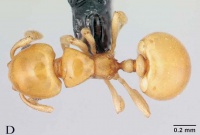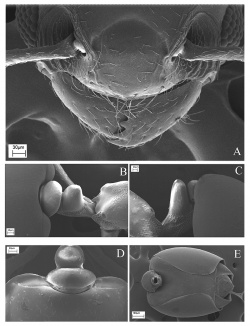Diaphoromyrma sofiae
| Diaphoromyrma sofiae | |
|---|---|

| |
| Scientific classification | |
| Kingdom: | Animalia |
| Phylum: | Arthropoda |
| Class: | Insecta |
| Order: | Hymenoptera |
| Family: | Formicidae |
| Subfamily: | Myrmicinae |
| Tribe: | Attini |
| Genus: | Diaphoromyrma |
| Species: | D. sofiae |
| Binomial name | |
| Diaphoromyrma sofiae Fernández, Delabie & do Nascimento, 2009 | |
The only species in the genus Diaphoromyrma, Diaphoromyrma sofiae is known only from collections gathered from litter samples.
Identification
Diaphoromyrma sofiae is the only species in the genus Diaphoromyrma. The combination of the following traits differentiate this taxon from any other in the subfamily Myrmicinae: antenna 9-segmented with a 2-segmented club, clypeus broad, clypeus with central apical hair, promesonotum trapezoidal, propodeal spiracles situated on lateral propodeal edges. The low position of the postpetiole and the sternal configuration of the first gastric segment are unique in Myrmicinae and apomorphic for the genus.
Distribution
Known from the state of Bahia, Brazil.
Latitudinal Distribution Pattern
Latitudinal Range: -16.252° to -16.393°.
| North Temperate |
North Subtropical |
Tropical | South Subtropical |
South Temperate |
- Source: AntMaps
Distribution based on Regional Taxon Lists
Neotropical Region: Brazil (type locality).
Distribution based on AntMaps
Distribution based on AntWeb specimens
Check data from AntWeb
Countries Occupied
| Number of countries occupied by this species based on AntWiki Regional Taxon Lists. In general, fewer countries occupied indicates a narrower range, while more countries indicates a more widespread species. |

|
Estimated Abundance
| Relative abundance based on number of AntMaps records per species (this species within the purple bar). Fewer records (to the left) indicates a less abundant/encountered species while more records (to the right) indicates more abundant/encountered species. |

|
Biology
This undescribed taxon was collected in litter samples taken in three rain forest remnants in the extreme southern portion of the State of Bahia, Brazil, using the Winkler technique. The landscape is dominated by forested valleys inserted in the coastal plateau (Barreiras Formation, Tertiary origin). Most of the vegetation of the remnants was in an initial or medium stage of regeneration, in a region where eucalypt plantations currently predominate. Forty 1 square-meter litter samples were taken in each remnant, and D. sofiae was found in 5%, 10%, and 25% of samples in the remnants Pequizeiro, Sucupira B, and Sucupira C at Santa-Cruz Cabrália, respectively, while it was collected in 4% of samples in the ESPAB Mata Atlântica coastal wet forest reserve at Porto Seguro using the same methodology. This finding reinforces the biotic importance of this region and the Atlantic coastal forest of Brazil in general, an abundant source of recent information on ant biodiversity and other important biological features (Lacau & Delabie 2002, Lacau et al. 2004, Mariano et al. 2004, Delabie et al., 2007, Fernández 2007).
Castes
Known only from the worker caste.
Nomenclature
The following information is derived from Barry Bolton's Online Catalogue of the Ants of the World.
- sofiae. Diaphoromyrma sofiae Fernández, Delabie & do Nascimento, 2009: 59, figs. 1, 2 (w.) BRAZIL (Bahia).
- Type-material: holotype worker, 50 paratype workers.
- Type-locality: holotype Brazil: Bahia, Santa Crtuz Cabrália, Sucupira-b, Veracel Celulose reserve areas, 16°16’32’’S, 39°16’13’’W, 5.xi.2006, Winkler trap (I.C. do Nascimento); paratypes: 18 workers with same data, 19 workers with same data but Sucupira-c, 16°15’08’’S, 39°16’55’’W, 1.xii.2006, 13 workers with same data as last but 19.i.2007.
- Type-depositories: CPDC (holotype); BMNH, CASC, CPDC, FRRJ, IAVH, ICNB, IMLT, INPA, LACM, MCZC, MIZA, MNHN, MZSP, PSWC, USNM (paratypes).
- Distribution: Brazil.
Unless otherwise noted the text for the remainder of this section is reported from the publication that includes the original description.
Description
Worker
Holotype (Paratypes n=10): HW 0.54 (0.51-0.54); HL 0.58 (0.57-0.60); SL 0.40 (0.39-0.40); EL 0.14 (0.14); PW 0.42 (0.39-0.42); WL 0.51 (0.47-0.56); PL 0.18 (0.15-0.22); PPL 0.13 (0.08-0.13); GL 0.90 (0.76-0.90); TL 2.39 (2.09-2.48); CI 93 (85-93); SI 74 (71-76).
Description. Head broadly triangular, with rounded sides, narrowed anteriorly, vertex and sides slightly convex. Mandibles triangular, with 5 teeth on the masticatory border, the apical and subapical larger than the others. Antenna with 9 segments. Scape clearly fails to reach the vertexal margin. Eyes well developed, situated near anterior margin of the head, with about 8 ommatidia in their maximum diameter. In dorsal view, promesonotum trapezoidal, sides and dorsum well defined. Promesonotum strongly convex in lateral view. Promesonotal suture well defined dorsally and laterally. Propodeum unarmed. Propodeal spiracles conspicuous, situated on the edge of declivitous face of propodeum, their aperture obliquely directed backward and upward. Metapleural gland bullae conspicuous, bigger than propodeal spiracle. Propodeal lobes small, rounded. Petiole in profile with short anterior peduncle, followed by a high and narrow node, its apex narrowly pointed. Petiolar peduncle attains petiolar mid length. Petiolar spiracle at base of node. Subpetiolar process present, as a keel-like lamella that ends in rounded apex anteriorly. Postpetiole low, rounded in frontal view, noticeably wider than long in dorsal view. Gaster without humeral angles basally. Head, promesonotum, petiole, postpetiole, gaster, scapes and legs smooth and shining. Lower side of mesopleuron and petiolar peduncle finely reticulated; propodeum with fine reticulation on the declivous face, between the propodeal spiracles and on the metasternal lobes. Body devoid of standing pilosity, except for very short, sparse minute hairs on head, legs and scape. Reclined minute hairs on thorax and gaster. Pilosity denser and longer on antennae. Row of hairs on the anterior clypeal margin, including median hair (not visible in the Automontage Picture). Central clypeal hair accompanied by two lateral hairs, although both lateral hairs not in the same plane (in full face view the 3 hairs appearing as the same length). Body yellow, eyes and mandibular teeth dark. Pilosity golden.
Type Material
Type material: Holotype worker, Brazil: Bahia, Santa Cruz Cabrália, Sucupira-b, Veracel Celulose reserve áreas, Winkler trap, 16º16’32”S 39º16’13”W, 5 November 2006, I. C. do Nascimento col., deposited in Laboratório de Mirmecologia CEPEC / CPDC.
Paratypes: 18 workers, same data as holotype; 19 workers, Brazil: Bahia, Santa Cruz Cabrália, Sucupirac, Winkler traps,16º15’08”S 39º16’55”W, 1 December 2006, I. C. do Nascimento col.; 13 Workers, Brazil, Bahia, Santa Cruz Cabrália, Sucupira-c, Winkler traps, 16º15’08”S 39º16’55”W, 19 January 2007, I. C do Nascimento col., deposited in The Natural History Museum, California Academy of Sciences, CPDC, Humboldt Institute, Instituto de Biologia Universidade Federal Rural do Rio de Janeiro, Insect Collection, Instituto de Ciencias Naturales, Fundacion e Instituto Miguel Lillo , Instituto Nacional de Pesquisas da Amazonia, Los Angeles County Museum of Natural History, Museum of Comparative Zoology, Instituto de Zoologia Agricola, Musee National d'Histoire Naturelle, Museu de Zoologia da Universidade de Sao Paulo, Philip S. Ward Collection, National Museum of Natural History.
Etymology
The specific name honors our colleague myrmecologist Sofia Campiolo, from Universidade Estadual de Santa Cruz (Bahia, Brazil) and Driades Institution, who obtained the research funds from Veracel Celulose, allowing an extensive regional ant survey.
References
- Fernández, F., Delabie, J.H.C. & do Nascimento, I.C. 2009. Diaphoromyrma, a new myrmicine ant genus from North Eastern Brazil. Zootaxa 2204: 55-62. PDF


